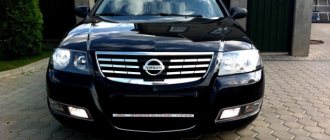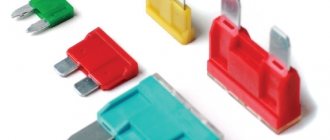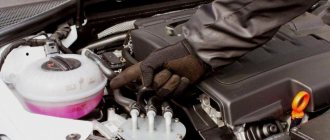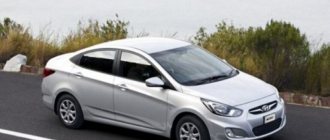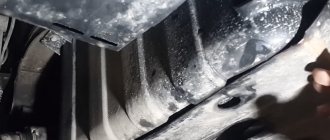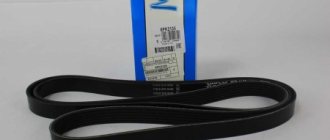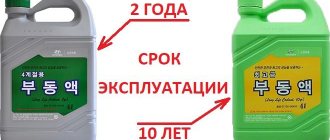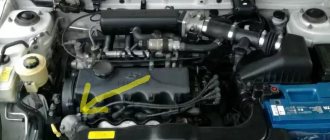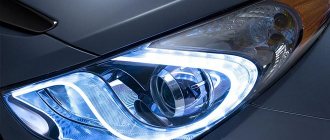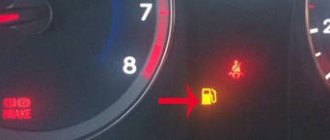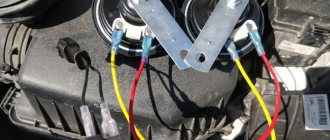Replacing any operating fluid is a standard procedure. Car owners need to regularly monitor the condition of the lubricants in the vehicle, check the oil and transmission mixture. The list of compounds used is not limited to this. You definitely need to worry about replacing the coolant - antifreeze.
I have a fashionable but budget car - a Hyundai Solaris 1.6 liter. The car is comfortable, but does not have a very powerful engine. However, you still need to use a cooler. In the article I will talk about what kind of antifreeze to fill in the Hyundai Solaris, and how to choose the right product?
What kind of antifreeze is poured into Solaris from the factory?
The car's instructions do not contain any specific explanations as to which antifreeze is best to pour into Solaris. There is a lot of information about the volume of the system and the principle of operation of the cooler. One important point is indicated - you need to fill the car with a mixture of ethylene glycol concentrated coolants and distillate.
Proportion 1:1. This option is provided in the vast majority of cases. However, for cars of different years of production, a completely different cooler is used:
- Hyundai Long Life Coolant (specification MS-591-08) – poured into cars assembled in Korea;
- antifreezes produced in Russia. They are characterized by low cost.
Original Hyundai antifreeze is very expensive, so vehicle owners rarely buy it. Some users note that the product is of lower quality than domestic antifreezes. Car manufacturers do not recommend filling in a product that has low technical characteristics. This is according to
Hyundai Solaris antifreeze: what you need to know
Let's start with the fact that modern internal combustion engines are very different from engines of previous generations. On the one hand, the engines themselves became more forced and loaded, the temperature control temperature increased, etc. On the other hand, for the manufacture of cylinder heads and cylinder heads, lightweight aluminum alloys began to be used, which have both pros and cons compared to cast iron.
Moreover, it is no secret that today lightweight aluminum blocks and cylinder heads are considered by many experienced drivers and internal combustion engine repair specialists to be more “capricious” and even disposable. As for the Solaris model, the engine also has an aluminum block with thin-walled dry cast iron liners. These sleeves are molded into the block during the manufacturing process. Also, the motor on Solaris has a phase change system and many other solutions.
The result is that a modern engine is technologically advanced and demanding in terms of quality of service. The engine is also boosted to obtain greater efficiency from a unit with a small displacement and at the same time to increase fuel efficiency and environmental friendliness of the internal combustion engine. Of course, such a power plant heats up to high temperatures during operation.
Of course, if even slight overheating occurs, parts will become deformed and the engine may be seriously damaged. This means that against the background of decreased strength and increased tendency of new motors to overheat, it is necessary to pay increased attention to the cooling system.
- If we talk about normal operation, keeping the cooling system clean and monitoring the coolant level in the system allows you to obtain high-quality cooling of the power plant. In turn, this affects the resource of the unit itself. The main thing is to choose the right antifreeze for Solaris. Let's figure out which antifreeze is best to pour into the Hyundai Solaris.
So, first of all, it is important to understand what kind of antifreeze is poured into Solaris from the factory. The fact is that the manual does not have a clear description of the brands of coolant. It is only indicated that you need to pour a mixture of ethylene glycol concentrated antifreeze and distilled water (1:1 proportions).
At the same time, for cars produced in different years, and also depending on the country of manufacture of the car, the antifreeze is different. So, the Koreans pour Hyundai Long Life Coolant (specification MS-591-08) at the factory. As for the Russian-assembled Solaris model, they are filled with CoolStream A-110, as well as Crown LLC A-110.
So, these types of coolants are produced in Russia, the price is more affordable and they end up on the assembly line. There is also original Hyundai fluid, but the price will be noticeably higher. In any case, Solaris manufacturers strongly do not recommend using any other types of coolant.
On the one hand, this is correct, but on the other hand, it may seem that the manufacturer is trying to force the pouring of only those liquids that the plant itself has determined. In fact, this is not true.
It is quite possible to select and actively use other analogues. It’s just important not to make a mistake when selecting other brands of antifreeze based on type and properties. You also need to take into account a number of nuances, which we will discuss below.
- First of all, you should pour antifreeze into Solaris and only that. Filling with antifreeze is prohibited! However, this is not all. It should be borne in mind that modern coolants are usually divided into groups. In other words, antifreezes differ from each other in composition and properties.
To put it simply, in addition to heat extraction, the coolant performs a number of additional functions in the system: lubrication of parts, protection against corrosion, etc. Also, this liquid should not boil or foam, and also retain the declared properties for a certain service life.
So, these properties are determined by the additives in the antifreeze that are added to the base. So, if the base is, for example, sodium phosphate (TOSOL), such coolants contain no corrosion inhibitors at all.
In turn, this liquid is not able to protect aluminum from destruction when heated. Of course, using such a liquid on the Solaris model will quickly damage the BC, radiator, etc.
- Let's move on. Silicate-based antifreezes are an obsolete type of coolant. Although they provide good protection against rust, the compounds also form deposits on the walls of the cooling system, which significantly impairs engine heat transfer. It turns out that the Hyundai Solaris will also not “digest” such antifreeze, the engine will overheat.
As for more modern solutions, this is carboxylate antifreeze, where aluminum and engine alloys protect organic acids from corrosion. This antifreeze does not form plaque and has an acceptable service life, but it must be changed strictly according to regulations. The reason is that over time, the anti-corrosion properties of the liquid deteriorate greatly and quickly.
All antifreezes of the latest generations are divided into 5 main groups: G11, G12, G12+ and G12++, as well as G13. So, it is prohibited to pour nitrite antifreeze marked TL into the Hyundai Solaris. In fact, the harm will be the same as from TOSOL.
What antifreeze to pour into Solaris
The recommended antifreeze for Hyundai Solaris should be at least G12.
More precisely, it is optimal to fill in G12, G12+ and G12++. By the way, it is also important to take into account that green antifreeze is poured at the factory. So, third-party antifreeze in the store can be of any color, and this in no way indicates compliance with one class or another. In other words, both G11 and G12 or G12+ can be green in color. It turns out that there is no need to navigate by color. You need to look at the class of the coolant itself.
For example, the recommended G12, G12+ and G12++ are usually red (G12++ can be pink or purple). So, it is quite possible to change the green factory antifreeze to red G12 or G12+, and it is not particularly important what the antifreeze manufacturer itself will be.
What properties should coolers have?
All types of antifreeze can be divided into several groups. Distribution occurs based on what properties a particular composition has:
- does not freeze in the cold and does not cause corrosion in the engine;
- lubricates the pump;
- does not boil at a temperature of 130-140 degrees Celsius;
- Using this product you can flush the cooling system;
- does not allow foam to form.
All these properties become available through the use of unique additive complexes. There are several antifreezes that are not recommended to be poured into the engine, as they can cause serious harm to the car. Particularly harmful compounds in this regard are colored blue. I don’t recommend pouring Soviet antifreeze into Solaris, since the car’s components will come to an end very quickly. Among modern ones, you should not fill in a nitrite composition marked TL.
Refrigerant quality check
When buying antifreeze, especially from a well-known brand, you are not immune from purchasing a low-grade counterfeit. Checking the quality of the purchased liquid is very simple - just determine its boiling point. For a good antifreeze it will not be lower than +107 °C at atmospheric pressure.
You can measure the indicators using a multimeter or infrared thermometer. When using the latter, keep in mind that the thermometer can give an error in the range from 3 to 7 degrees.
In addition to determining the boiling point, you can evaluate the color of the coolant after a certain period of its operation. Counterfeit goods very quickly lose their original color and become colorless or brown.
Is it allowed to mix antifreeze of different brands?
You should not combine products from different brands, although there are exceptions. To top up in small quantities, you should use distilled or ordinary water. In the future, it is better to completely replace all antifreeze than to mix it with another liquid. Before filling in a new cooler, it is recommended to flush the system with distillate.
The first signal indicating that a fluid change is required is a loss of color. The second point is the operating conditions. The higher the temperature, the more liquid will evaporate. This means that for cars operating in difficult conditions, antifreeze needs to be changed more often. Each car has its own rules for replacement; here it is important to act strictly according to the instructions.
Coolant replacement intervals
The plant recommends the first replacement of antifreeze after 210 thousand kilometers or 120 months of vehicle operation. However, to avoid problems with the pump, you should not wait for these indicators, especially if the car is used not only on the highway, but also in the city. The fact is that in traffic jams the temperature of the coolant rises by almost 10 degrees (this is why the radiator cooling fan often works in hot weather). This negatively affects the life of the antifreeze. Therefore, it is better to change it 3 years after purchasing the car or upon reaching 45 thousand km.
In the future, the procedure must be carried out every 30 thousand km or 24 months.
If the coolant has changed color, become cloudy and formed a sediment before the scheduled replacement, the frequency will have to be adjusted.
Replacing antifreeze in Hyundai Solaris - step-by-step instructions
Immediately before starting to change the fluid, it is worth studying the layout of the corresponding tank. The decision to replace should be made after the coolant level has been determined to be low.
When the consumption is more than a liter per 10 thousand km, this indicates a malfunction in the system, which means it’s time to start replacing the product. You need to do this:
- Remove the reservoir cap and radiator cap. Remove the shield that protects the power unit from dirt.
- Carefully unscrew the drain valve, but not all the way. This will reduce the degree of pressure and the volume of the drained mixture. Place a container under the old antifreeze.
- When draining antifreeze, you need to check the condition of the sealing ring. If it is cracked, it needs to be replaced.
- Remove the remaining coolant using a special syringe or syringe bulb.
- Close the tap and fill the coolant tank to the level marked “L”. Close the traffic jam and start the car.
After the replacement is completed, an air lock may appear in the car, but within an hour or two it will go away on its own.
What kind of coolant should I fill?
When performing work at an authorized dealer, original CoolStream A-110 or Crown LLC A-110 fluids are poured into the machine. A good alternative would be the already mentioned Hyundai Long Life Coolant (article 07100-00200 and 07100-00400). In addition to them, you can use any concentrates or ready-made liquids that comply with the G12+, G12++ and G13 standards. Some owners mistakenly believe that the green color of Korean antifreeze corresponds to the more common Volkswagen class G11 and pour such refrigerants into the cooling system. Filling Solaris with G11 antifreeze or antifreeze is strictly prohibited. You should not buy very cheap liquids, as they may not be of high quality.
How to replace antifreeze on Solaris?
Antifreeze is designed to maintain a constant temperature of a running engine. The cooling system prevents overheating of the involved components and connections, reducing wear of parts due to high temperatures.
According to technical regulations, replacement of antifreeze for Hyundai Solaris from the manufacturer is carried out after 200 thousand mileage or 10 years of service. Depending on operating conditions, these values may be reduced.
The frequency of replacing new coolant is every 30 thousand kilometers or 2 years. The indicators are given taking into account the high-quality concentrate; if necessary, the coolant is changed more often.
To independently replace antifreeze, prepare the following equipment :
- pliers, a set of screwdrivers and wrenches;
- rubber bulb with hose, rags, funnel;
- gloves, clean rag;
- container for draining from 5 liters, taking into account washing, additional containers will be needed;
- consumables - new coolant, flushing agent, distilled water.
During the inspection, parts and components may be identified that require replacement or repair. Taking this factor into account, it is recommended to inspect the system in advance and prepare all the necessary parts.
When working with antifreeze, safety . Many drivers disconnect the minus voltage on the battery as an additional precaution. If the engine has recently been running, allow it to cool.
The coolant in the system is under pressure; all caps and taps are opened carefully, taking into account possible splashes. If the engine is not cool enough, burns to your hands and face are possible.
Pay attention to the high toxicity of antifreeze. The driver should take measures to prevent used or new fluid from entering the soil. They also pay attention to the danger to animals and children who may be nearby.
Replacing antifreeze for a Hyundai Solaris involves a certain procedure, conventionally divided into three main stages - draining the used fluid, flushing the system and filling in a new one. For clarity, each of the stages is considered in a separate order.
Stage one
To properly drain a Hyundai, you should carry out the following procedure:
- The car is parked on a flat surface and the engine is allowed to cool;
- Using a 10mm wrench, unscrew the bolts holding the left engine mudguard and remove it;
- carefully unscrew the radiator filler cap;
- There is a drain valve located at the bottom left of the radiator - turn it two or three turns, after placing a container under the drain, usually using a basin;
- using pliers, remove the hose connected to the radiator from the neck, and also place a container under it for draining;
- uncork the expansion tank and use a bulb to pump out the remaining antifreeze.
About 5 liters of waste fluid should drain. After this, all connections are joined in the reverse order, and the system is returned to its original position.
Stage two
Flushing the cooling system is not considered a mandatory step in replacing antifreeze. It is relevant when identifying low-quality coolant or switching to a new brand. It will also be needed when repairing or replacing units.
To flush the cooling system from waste liquid, follow a certain procedure:
- after bringing the system to its original state, flushing liquid is poured into the filler neck;
- the engine is warmed up to operating temperature, usually for 15 minutes, then turned off and allowed to cool;
- after this, the flushing is drained using the same procedure by which used antifreeze is removed.
If you use flushing fluid, you will need to repeat the procedure using distilled water. The washing is repeated until the drained water is relatively clean.
Stage three
Pouring new antifreeze into the cooling system is the easiest of the steps. To implement this, you should tighten all joints after washing and check the tightness of the fasteners. Next, coolant is poured into the radiator filler neck.
As soon as the antifreeze begins to flow into the expansion tank, stop filling and close the radiator. The remainder is poured into the expansion tank, a couple of centimeters above the L mark.
Next, the engine is warmed up, monitoring the air supply at operating temperature. After this, the coolant level is checked and, if necessary, topped up to the maximum level.
A few days after replacement, the level and condition of the antifreeze will need to be checked again. If the volume has decreased, add the required amount and check all joints and connections for possible leaks.
If the color of the liquid changes to brown or becomes discolored, you will need to replace the antifreeze again with mandatory flushing of the system. High-quality antifreeze does not change color over time, it can only darken.
Level control and required volume
The maximum capacity of the Solaris engine cooling system is 5.3 liters.
To control the liquid level in the system, a translucent expansion tank is used. It is installed directly on the radiator of the cooling system on the right side. On the front surface of the tank there are two notches with the designations L (low - low) and F (full - full). The volume of liquid in normal condition should be near the upper mark. The system will fully cool the engine only at this level. When the amount of liquid drops below the middle, especially below the L mark, refrigerant is added. Only add antifreeze of the brand that is in the system. Topping up is carried out through a special sliding funnel pipe located in the neck of the tank.
The tank is circled in red; liquid level marks are visible on the wall.
Possible causes of coolant consumption
During vehicle operation, the fluid level may decrease slightly. This is due to the fact that the expansion tank of the Hyundai cooling system is not completely sealed and antifreeze can evaporate from it. Significant loss of refrigerant within a short time indicates possible damage to the pipes or radiator. In this case, it is necessary to check the system and repair the damaged areas.
In this case, you should check that there is no antifreeze in the engine lubrication system. This happens when the sealing gasket between the head and the cylinder block is destroyed. If there is liquid in the oil, its level in the crankcase will increase significantly and traces of the emulsion will be visible on the dipstick.
Where to see the fluid level and color
If the car is cold and you just want to see the color of the fluid, it is more convenient to do it here.
On a warm car, the fluid level can be viewed here.
Over time, the tank becomes cloudy, and it becomes difficult to see the level and, even more so, understand the color of antifreeze. In this case, even with a warm car, you can remove the cap from the reservoir and determine the fluid level using the hose. If you look into the tank, you can see the color.
Leaks and problems
Hyundai Solaris does not have any particular problems with the cooling system. Unless the filler cap should be changed periodically. Since sometimes the bypass valve located in it fails. This creates increased pressure, which sometimes leads to leaks at the joints.
Sometimes users may complain about increased engine temperature; this can be treated, as it turns out, by externally flushing the radiator. Over time, dirt gets into the small cells, which disrupts normal heat exchange. As a rule, this happens on older cars that have had time to travel in various conditions.
2272-4-9-05
Pour coolant through the filler neck until the liquid flows into the expansion tank.
Pour liquid into the expansion tank 3–4 cm above the L mark. Close the expansion tank lid.
We start the engine, stop it after two minutes of operation and add liquid to the filler neck of the cooling system. Close the filler cap of the cooling system and warm up the engine. We stop the engine and after it has cooled down, check the coolant level and bring it to normal.
Hyundai Solaris coolant replacement
A little about concentrated formulations
The basic recommendation for preparing ready-made antifreeze from concentrates is the same: 50% emulsion to 50% distilled water. This is, in general. If you carefully read the manual, you can see the profile plate. It provides the relationship between the minimum operating temperature of antifreeze, the concentrations of commercial emulsion and deionized water:
| Freezing temperature, °C | Concentrated antifreeze, % | Water, % |
| -15 | 35 | 65 |
| -25 | 40 | 60 |
| -35 | 50 | 50 |
| -45 | 60 | 40 |
- Note for those purchasing a pre-made unlicensed product. The manufacturer warns that you should not buy solutions with a mass fraction of antifreeze content of less than 35% and more than 60%. They are ineffective.
Adviсe
The nominal volume of the internal channels of the cooling system is 5.3 liters. Since the drain is made only from the radiator part and the expansion tank, coolant remains in the engine and heater core. Therefore, the amount of liquid is about 4 liters.
When changing the composition, an air lock may be created. If it has formed, and on a warm engine this will be indicated by cold air flowing from the interior heating system, then you should stop the internal combustion engine and allow it to cool. Afterwards, remove the cap from the radiator and start the engine for a few minutes - the air will come out.
Consequences of untimely replacement
Long-term use of antifreeze leads to the destruction of the components included in its composition. In this case, precipitation or foam may form on the surface of the refrigerant in the expansion tank. These deposits clog the fluid supply channels in the block and cylinder head and impair engine heat transfer. In addition, they enter into various chemical reactions with metal and rubber parts of the cooling system. This often leads to the destruction of elements, the appearance of leaks from the system and even greater clogging.
